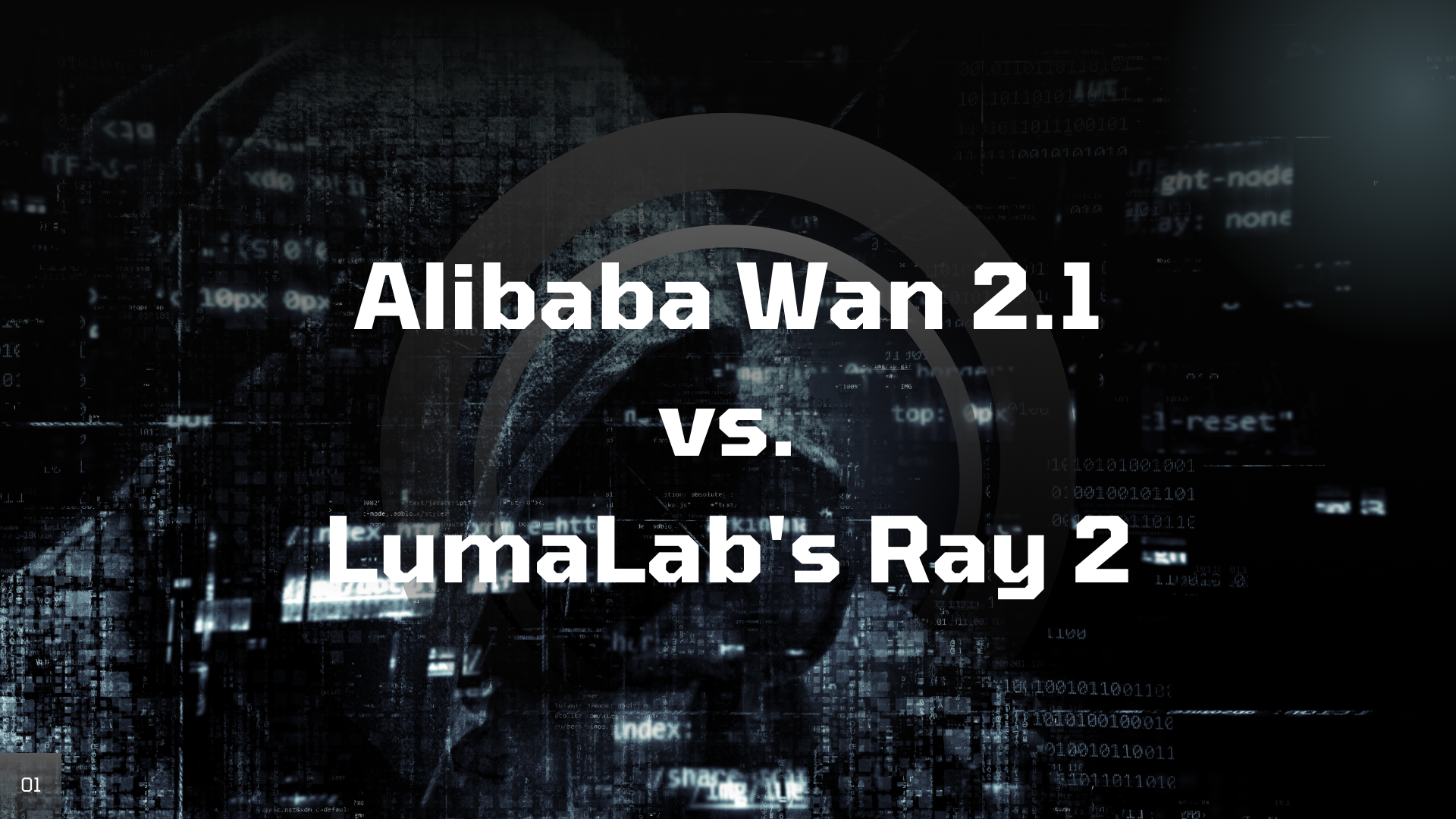Alibaba Wan 2.1 vs LumaLab's Ray 2: Best Video Generation Model?

The field of artificial intelligence (AI)-driven video generation has undergone significant advancements, with models such as Alibaba’s Wan 2.1 and LumaLab’s Ray 2 at the forefront.
These state-of-the-art models exemplify the latest innovations in text-to-video (T2V) and image-to-video (I2V) synthesis, each offering unique computational methodologies and practical applications.
Architectural and Functional Overview of Alibaba Wan 2.1
Alibaba's Wan 2.1 is an open-source generative AI model engineered to produce high-fidelity video sequences. Building upon the foundations laid by its predecessor, Wan 1, this iteration introduces refined motion coherence, superior resolution, and multilingual adaptability.
Key Attributes of Wan 2.1
- Text-to-Video (T2V) and Image-to-Video (I2V) Capabilities: Enables the generation of dynamic video sequences from textual prompts and static imagery, ensuring fluid motion and realistic scene transitions.
- High-Resolution Synthesis: Supports video output at up to 1080p resolution, maintaining 30 frames per second (FPS) for enhanced visual quality.
- Multilingual Compatibility: Processes textual input in both English and Chinese, facilitating global usability.
- Optimized Computational Demands: Requires a minimum of 8.19GB VRAM, rendering it accessible to users operating consumer-grade GPU architectures.
- Open-Source Distribution: Available via platforms such as Alibaba Cloud’s ModelScope and Hugging Face, fostering collaborative research and iterative development.
Technical Underpinnings
Wan 2.1 leverages a spatio-temporal variational autoencoder (VAE) integrated with Diffusion Transformer architectures.
These methodologies optimize the model’s ability to encode and synthesize complex motion patterns while preserving temporal consistency, making it adept at producing sequences involving intricate physical interactions, such as those observed in fluid dynamics and biomechanical simulations.
Example Implementation: Video Generation with Wan 2.1
from modelscope.pipelines import pipeline
from modelscope.utils.constant import Tasks
pipe = pipeline(task=Tasks.text_to_video, model='wan2.1')
result = pipe({'text': 'A robotic arm assembling a circuit board'})
result.save('wan_output.mp4')
Architectural and Functional Overview of LumaLab’s Ray 2
LumaLab’s Ray 2 distinguishes itself with a strong emphasis on cinematic visual fidelity and artistic control. While proprietary in nature, this model has demonstrated significant capabilities in high-resolution content creation for professional-grade applications.
Key Attributes of Ray 2
- Cinematic-Grade Output: Focuses on enhancing photorealistic rendering, achieving near-film-quality synthesis.
- Enhanced Creative Modulation: Provides granular control over scene composition, including lighting effects, motion interpolation, and visual aesthetics.
- Dynamic Scene Customization: Features user-adjustable parameters to modify scene transitions, object interactions, and temporal consistency.
Technical Underpinnings
Ray 2 employs a neural rendering approach that integrates generative adversarial networks (GANs) with reinforcement learning-driven optimization.
By refining pixel density and leveraging a modular synthesis framework, Ray 2 offers unparalleled detail enhancement and stylistic coherence tailored for creative professionals.
Example Implementation: Video Generation with Ray 2
from ray2 import VideoGenerator
generator = VideoGenerator()
video = generator.create_video(prompt='A futuristic cityscape at dusk with flying cars')
video.save('ray_output.mp4')
Comparative Feature Analysis: Wan 2.1 vs. Ray 2
| Feature | Alibaba Wan 2.1 | LumaLab's Ray 2 |
|---|---|---|
| Resolution | Up to 1080p at 30 FPS | Cinematic-grade (resolution unspecified) |
| Multilingual Support | English, Chinese | Limited public documentation |
| Hardware Requirements | Optimized for consumer GPUs (8.19GB VRAM) | Likely requires high-end GPU systems |
| Editing and Customization | Supports pre-processed inputs | Advanced, real-time scene adjustments |
| Open Source Availability | Yes | No |
| Benchmark Performance | Top-ranked on VBench leaderboard | Not publicly disclosed |
Contextual Applications and Industry Relevance
Alibaba Wan 2.1: Practical Use Cases
Wan 2.1’s accessibility and efficiency make it a viable tool across multiple sectors:
- Digital Content Creation: Accelerates social media and marketing video production with automated synthesis.
- Academic Research: Facilitates AI-driven motion analysis and generative video studies.
- Entertainment: Enables rapid prototyping of animations and immersive media projects.
LumaLab’s Ray 2: Practical Use Cases
Ray 2 is tailored for scenarios demanding cinematic precision and artistic refinement:
- Film and Television Production: Serves as a supplementary tool for visual effects and previsualization workflows.
- Advertising and Branding: Enables hyper-realistic promotional video generation.
- Artistic Experimentation: Provides an AI-assisted medium for avant-garde visual compositions.
Performance Assessment
Computational Efficiency
Wan 2.1 exhibits high computational efficiency, generating a five-second video within four minutes on an RTX 4090 GPU. Ray 2’s processing speed remains undisclosed, though its focus on high-fidelity rendering suggests a potentially longer processing time.
Output Fidelity
While Wan 2.1 ensures structural and motion integrity, Ray 2 surpasses it in aesthetic refinement and cinematic depth, making it more suitable for professional storytelling applications.
Accessibility and Scalability
Wan 2.1, as an open-source framework, is widely available for academic and commercial experimentation. Conversely, Ray 2’s proprietary nature restricts its accessibility to select industries and enterprise-level users.
Strengths and Limitations
Alibaba Wan 2.1
Advantages:
- Open-source availability fosters extensibility and innovation.
- Computational efficiency enhances real-world usability.
- Supports multilingual text input, increasing global accessibility.
Limitations:
- Prioritizes structural accuracy over stylistic expressiveness.
LumaLab’s Ray 2
Advantages:
- Superior rendering quality suitable for high-budget productions.
- Offers extensive customization and artistic control.
Limitations:
- Proprietary restrictions limit accessibility and academic research.
- Higher computational demands necessitate advanced hardware setups.
Conclusion: Model Selection Considerations
The selection between Alibaba Wan 2.1 and LumaLab’s Ray 2 depends on the specific use case:
- For researchers, developers, and content creators requiring an accessible, efficient, and versatile video generation tool, Alibaba Wan 2.1 presents the optimal choice.
- For professionals in film production, digital art, and advertising who prioritize aesthetic precision and granular customization, LumaLab’s Ray 2 is the more suitable alternative.
Both models represent significant advancements in AI-powered video synthesis, each catering to distinct domains within the broader landscape of computational media generation.